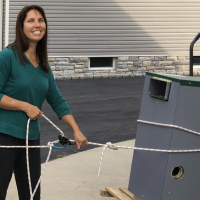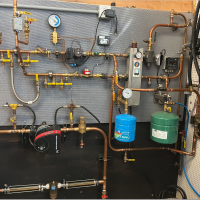Your thoughts and opinions please

I was asked to do a 3 1/2 hour class in Pittsburgh next month. They would like a hybrid class, one hour on hydronic, one on low pressure steam and one on reading boiler wiring diagrams. I put together an outline and would love your feedback on what Im including. What would you or your techs want to learn? Thanks so much for your thoughts on this.
Ray
Hybrid Class Steam Hydronic Electric
Class Outline: Top Ten Problems in Hydronic, Steam, and Wiring Diagrams
Introduction (5 minutes)
Section 1: Hydronic Heating Systems (60 minutes)
Top Errors & Problems
- Air in the system – symptoms, prevention, removal
- Improper circulator location (pumping toward vs. away from the expansion tank)
- Wrong circulator sizing – sizing a circulator
- Insufficient expansion tank capacity – waterlogging, relief valve discharge
- Mixing glycol incorrectly – concentration, leaks, efficiency loss
- Lack of water treatment – corrosion, scale, oxygen ingress
- Undersized piping – high velocity noise, poor flow distribution
- Boiler system controls – residential & commercial PTA, control, limit, low water
- ystem balancing – hot/cold zones, valve adjustments,
- Neglected maintenance – dirty strainers, plugged air vents, circulator wear
- What you must do before connecting a new boiler to old pipes – flushing system, checking flue, chimney
Break
Section 2: Low-Pressure Steam Heating Systems (60 minutes)
Top Errors & Problems
- Poor or missing main venting – long warmup times, uneven heating
- Radiator vent problems – stuck open/closed, mismatched sizes
- Water level issues – surging, flooding, dry firing risks
- Improper near-boiler piping – header height, equalizer, carryover
- Neglected low-water cutoffs – blowdown frequency, failures cause accidents
- Condensate return issues – leaks, hammer, waterlogged returns
- Incorrect pressure settings – high pressure wastes fuel, short-cycles
- Oversized boilers – short cycling, fuel waste, wet steam
- Dirty boiler water – oils, sludge, need for skimming/flushing
- Ignoring insulation – bare pipes = wasted energy & poor balance
- Water Hammer – why are the pipes banging
Break
Section 3: Reading Wiring Diagrams (60 minutes)
Top Errors & Problems
- Confusing line vs. low-voltage circuits
- Misidentifying series vs. parallel wiring
- Not following electric flow (power source → switch → load → neutral)
- Skipping safety switches – high limit, LWCO, rollout switches
- Misreading symbols – pump, transformer, contactor, relay coil
- Assuming color coding = function (colors vary by manufacturer)
- Overlooking common/neutral connections
- Not verifying with a meter – trusting the drawing only
- Failing to read legend or notes on the print
- Troubleshooting blindly – not breaking the circuit into sections
Wrap-Up & Q&A (10 minutes)
Boiler Lessons
Comments
-
Wow That looks pretty comprehensive. Are you going to be able to squeeze all that into one hour each? You man need to look at some of the importance of each item and be prepared to glaze over some of them as you watch the clock in order to cover the important points.
When I did my one day seminars on Hydronics, I had a 4 minute blurb on steam boilers where I used one power point slide to touch on important basics, then told the mechanics in the class to put their hands in their pockets and step back and call someone that knows about steam.
I also stopped my presentation in the middle of discussing safety devices like high limits, flame safety controls, and relief valves. I had three slides to go over the importance of "Operating" the relief valve. I had a blow up of the yellow tor green tag that is usually torn off, that states: "YOU MUST OPERATE THE RELIEF VALVE ANNUALLY" and highlighted those words and zoomed in on them. Dan H taught me that one. Then I asked about what does a maintenance visit include?, and why the mechanics don't operate PR valves as part of the maintenance? If the valve fails, you have a sale for a new valve if you present it properly, and doesn't your boss like it when you sell stuff over and above the loss leader maintenance price? Aren’t we in the business to replace defective parts?
Edward Young Retired
After you make that expensive repair and you still have the same problem, What will you check next?
1 -
I think you've got all the major topics covered. But what if someone has a question? There's always questions. And if you want all that information to sink in, those questions need time for answers. From what you're covering, I would think 6 hours minimum. You could probably go deeper with 8 hours and still not be boring.
This class is for service techs and installers? All levels?
0 -
Ray, I agree with the comments above.
I am being brutally honest here, not trying to be disrespectful.
Do you want to listen to yourself talk, or do you want to teach. What I am trying to say is, let it sink in. Give the students time to respond. Reduce the amount of information you are trying to fit into a few hours.
Ask the class for responses to your questions to judge if they are picking up what you are putting down.
For example, you are gong to cover sizing a circulator pump in what, about four minutes? I am amazed at the amount of people in the trade that have no idea how to size a circulator. This includes service techs, installers, supply house "designers", and even some reps. I think you could spend an hour easily just on on sizing and identifying pumps.
With regard to electrical troubleshooting, keep it simple. Think of the hundreds or thousands of no heat calls you have been on. Only focus on the the common problems, not the obscure with such a short time frame. Start with simple hand drawn line diagrams, show the people how a simple circuit works. Use water, valves and pipes as examples. Then work your way up to more complicated examples based on the response you get.
I am thinking back to Dan Holohan's early seminar days. He made it simple, fun, had props, and spoke in a language that most of us understood. Everyone I spoke to after one of Dan's seminars learned something, most learned a lot. For me, I learned plenty and I gained confidence in what I was unsure of.
Hopefully your students will learn something and ask plenty of questions.
3 -
I didn’t see anything (unless I missed it), about proper sizing and problems with oversizing.
Honestly it could (should) be an 8 hour class.
0 -
Could be 8 hrs on steam, 8 hours on water and 8 on electrical but that's not what the customer wants.
Depends on the knowledge level of the students.
If they ask a lot of questions you may run out of time.
0 -
-
Your curriculum is excellent for a well seasoned person with years of experience as a brush up and review...A full day class, no less. It's a pretty good bet, the class experience will vary greatly. Could it be that this is the client's wish list? Cover all bases AND in 3.5 hours?
Just covering all those points, without anyone asking a single question is rough. I would run my concerns by the client, hopefully he will modify accordingly. All salient points from the guys. Mad Dog
1 -
Speaking as a homeowner,
I would add this to items number one and item number 4.
Item no. 1a; how the steel compression increases expansion tank capacity at a lower cost uses smaller piping and improves air removal with the airtrol valve if an air scoop is used or not and how it works silently and how it will outlast every boiler installed under it as long as it is properly installed.
Item no. 4a; how the steel compression tank eliminates automatic water feeders, automatic air vents and the problems with them leaking and ruptured bladders and the resulting water logging and the loss of the point of pressure change.
0 -
-
First of all Thanks to everyone. I have been fighting with this as each topic could be 8 hours or more. The customer was thinking of a quick thing about what to look for on each type system. For example, what's the system pressure, delta t on a hydronic system Near boiler piping and boiler pressure on a steam I guess they were hoping I could do the matrix thing and just upload knowledge. Back to the drawing board. You guys are awesome Thanks
Ray Wohlfarth
Boiler Lessons2 -
A lot of these hydro topics can be sort of breezed through to fit in an hour but I do worry that pump sizing, pipe sizing, and expansion tank sizing may raise so many questions that these topics dominate the hydro hour. I might condense them all into one topic and move them toward the end, and print some cheat sheets for these topics so you don't need to get too deep, each one could be an hour in itself give or take. If I were planning to teach to the service techs I would avoid sizing topics personally, and focus on the things I want service techs to do better on the jobs I visit, If I were teaching owner operators, or designers I would be happy to get in the weeds of sizing topics, thats where sizing gets the most use anyway.
Personally I think you could get through all these topics in the allotted time, I just might condense a few subjects in case you have a good audience that is asking questions. Im sure planning for 3.5 hours you figure it will actually be about 4 though, I would definitely allow enough time for about 10 minute of Q&A in each section if needed in addition to the break time
0 -
You need to figure out what level your audience is at. I suspect it is mixed which will make touching on all that in such a short time really hard.
I think the only way you have a chance of covering all that in a couple hours is by describing how a hot water system works and how a steam system works and covering all those points in your description.
0 -
I would add one thing to @ScottSecor's comment: After you hone in on your presentation, Practice in front of the mirror with the stop watch to see if it fits! 45 minutes in front of the mirror = 1 hour in the classroom.
Edward Young Retired
After you make that expensive repair and you still have the same problem, What will you check next?
0 -
“The customer was thinking of a quick thing about what to look for on each type system.”
Herein lies the problem: They want you to give them in less than 4 hours what you’ve spent a lifetime learning.
It takes 12 years to get a high school diploma, another 4 to get a bachelor’s degree;, 3 more to get a master’s, and 1-2 more to earn a doctorate. But somehow, they expect you to be able to condense what you’ve learned through decades into 3-1/2 hours. It’s just part of the instant gratification culture in which we live.
I would suggest that you reduce it down to maybe one two sub points from each main topic that you feel are most needed and spend a little time emphasizing that it takes a lot more time and effort to get a working understanding of hydronics and then promote you books and videos along with this site. Those that really want to learn will take your advice.
Bob Boan
You can choose to do what you want, but you cannot choose the consequences.6 -
I'd give them TLAOSH and Modern Hydronic Heating and Idronics as things to look at for more information too.
0 -
-
In addition to air in HHW I'd address proper pressure.
Defeating safeties is another important issue that ought to be emphasized.
0
Categories
- All Categories
- 87.3K THE MAIN WALL
- 3.2K A-C, Heat Pumps & Refrigeration
- 61 Biomass
- 429 Carbon Monoxide Awareness
- 120 Chimneys & Flues
- 2.1K Domestic Hot Water
- 5.8K Gas Heating
- 114 Geothermal
- 166 Indoor-Air Quality
- 3.7K Oil Heating
- 77 Pipe Deterioration
- 1K Plumbing
- 6.5K Radiant Heating
- 395 Solar
- 15.7K Strictly Steam
- 3.4K Thermostats and Controls
- 56 Water Quality
- 51 Industry Classes
- 50 Job Opportunities
- 18 Recall Announcements










